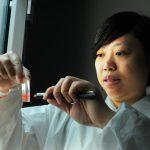
One in six men will be diagnosed with prostate cancer during his lifetime, the second leading cause of death among men in the United States.
It’s a serious problem and current diagnostic tests aren’t very specific. But a research team at the University of Central Florida NanoScience Technology Center has found a more accurate test that not only determines whether a patient has prostate cancer, but also how aggressive it is.
“That’s really what is unique and exciting about our new discovery,” said associate professor Qun “Treen” Huo, the lead investigator on the project. “Our nanoparticles not only seek out a chemical reaction that is specific to prostate cancer, they can also tell us how aggressive the cancerous cells are likely to be, which can give doctors better information to treat their patients.”
Current tests can’t tell how aggressive the cancer is, which often leads to the gland’s removal when other options might be available. For example, a very aggressive type of cancer in a young man may require immediate removal of his prostate gland to save his life. A slow-acting cancer in a young patient may give him more options that are less radical.
And options are good because the prostate is a very important gland. It helps regulate urine flow and is involved in the production of semen in men. The effects of surgical removal of the prostate gland can range from mild loss of erection and pain on orgasm, to total loss of erection and incontinence.
Huo’s work is published in the Journal of Translational Medicine today.
The technique is rather simple, Huo said.
She uses gold nanoparticles that detect a specific chemical reaction between a prostate tumor and the human immunoglobulin G (IgG). IgG is an abundant protein circulating in the blood. Research has shown that IgG likes to stick to the surface of the gold nanoparticles to form a protein corona. This corona can be detected by a technique called dynamic light scattering. Huo found that when cancer cells are present, they can “destroy” the IgG in the blood, and this specific interaction is picked up by the gold nanoparticles. Using this simple test, Huo can determine quantitatively how aggressive the prostate tumors are and the likelihood they will metastasize. The team tested out the technique on human tissue samples.
“We’ve had already done our study with animal and human blood samples,” (J. Nanobiotechnology, ) Huo said. “Now we’ve confirmed our findings in both animal models and human tissue samples. I am in the process of conducting a validation study with the Florida Hospital Cancer Institute and I am very confidant the technology works.”
If all goes well, clinical trials could begin in two to three years, and Huo hopes the diagnostic tool could be routinely used by physicians in as little as five years. The test most likely would be used to supplement those already used to provide doctors with more quantitative and accurate information, which could lead to more treatment options.
The system that detects the reaction was discovered in Huo’s lab four years ago. It’s called “nanoparticle-enabled dynamic light scattering assay (NanoDLSay) and it is being used by many researchers around the world for everything from detecting cancer in blood to finding lead in water.
“We’re looking for funding now to get to the next step,” Huo said.
The National Science Foundation and the Florida Department of Health Bankhead-Coley Foundation funded a lot of the basic research that went into creating the new technology.
“Ultimately it’s about working together to help doctors help patients,” Huo said. “That’s why I research cancer. I want to help make that happen.”
Collaborators on the project include: Shannon Sullivan and Hillari Hallquist also from the UCF NanoScience Technology Center, and Sally A. Litherland, Dr. David A. Decker and Inoel Rivera-Ramirez from the Florida Hospital Cancer Institute.
Huo joined UCF in 2005 after working as an assistant professor at North Dakota State University. She has a doctorate degree in chemistry from the University of Miami and completed a postdoctoral fellowship at the same institution. She earned a National Science Foundation CAREER award among other recognition. She also is a panel review member for the National Institutes of Health. She has several patents for her innovative work. At UCF she works at the NanoScience Technology Center and has joint appointments in the department of chemistry, college of medicine and department of mechanics, materials and aerospace engineering. She also is president of Nano Discovery Inc. a start-up company that she cofounded to commercialize NanoDLSay.
Reprinted from UCF Today.